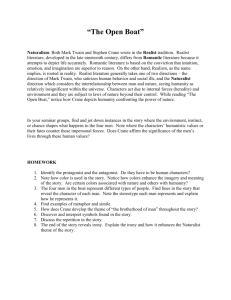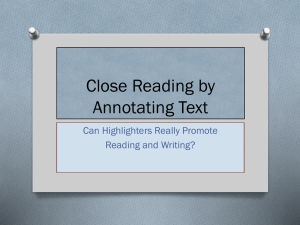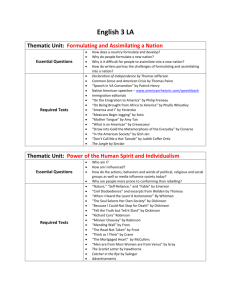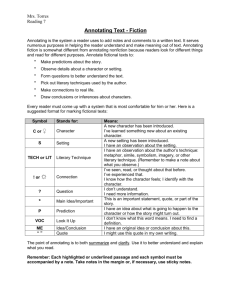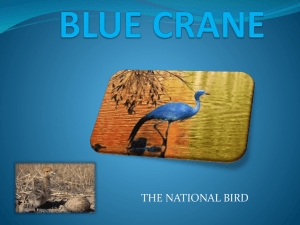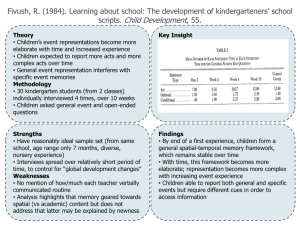Close Reading & Annotation Review Exercise: “The Open Boat” by
advertisement
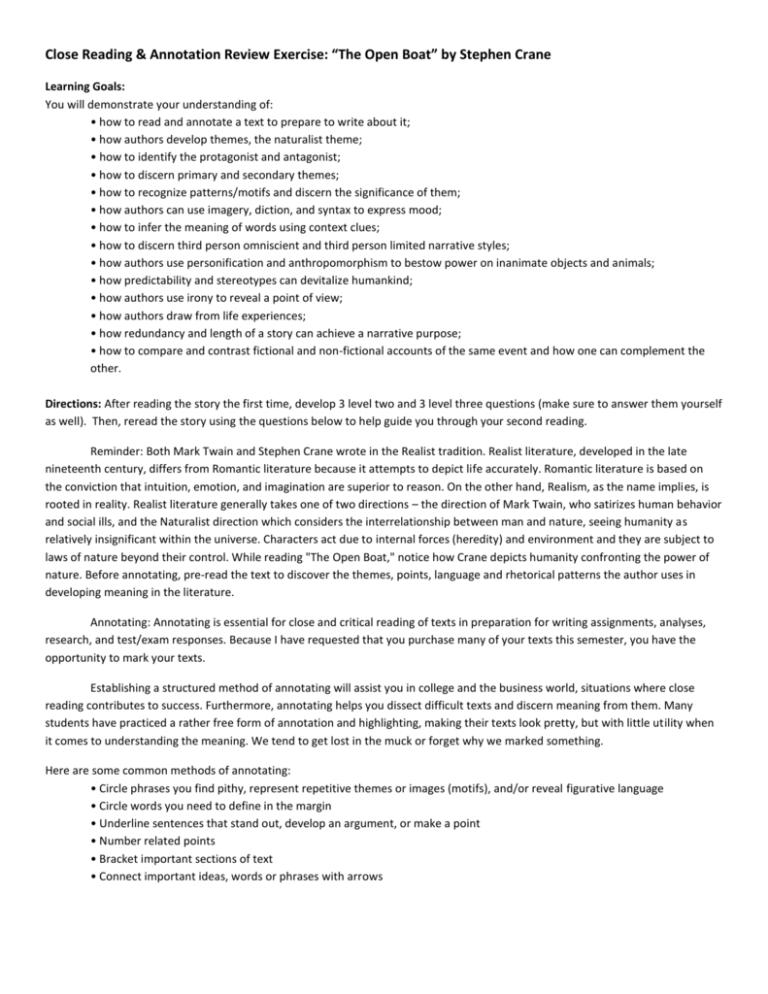
Close Reading & Annotation Review Exercise: “The Open Boat” by Stephen Crane Learning Goals: You will demonstrate your understanding of: • how to read and annotate a text to prepare to write about it; • how authors develop themes, the naturalist theme; • how to identify the protagonist and antagonist; • how to discern primary and secondary themes; • how to recognize patterns/motifs and discern the significance of them; • how authors can use imagery, diction, and syntax to express mood; • how to infer the meaning of words using context clues; • how to discern third person omniscient and third person limited narrative styles; • how authors use personification and anthropomorphism to bestow power on inanimate objects and animals; • how predictability and stereotypes can devitalize humankind; • how authors use irony to reveal a point of view; • how authors draw from life experiences; • how redundancy and length of a story can achieve a narrative purpose; • how to compare and contrast fictional and non-fictional accounts of the same event and how one can complement the other. Directions: After reading the story the first time, develop 3 level two and 3 level three questions (make sure to answer them yourself as well). Then, reread the story using the questions below to help guide you through your second reading. Reminder: Both Mark Twain and Stephen Crane wrote in the Realist tradition. Realist literature, developed in the late nineteenth century, differs from Romantic literature because it attempts to depict life accurately. Romantic literature is based on the conviction that intuition, emotion, and imagination are superior to reason. On the other hand, Realism, as the name implies, is rooted in reality. Realist literature generally takes one of two directions – the direction of Mark Twain, who satirizes human behavior and social ills, and the Naturalist direction which considers the interrelationship between man and nature, seeing humanity as relatively insignificant within the universe. Characters act due to internal forces (heredity) and environment and they are subject to laws of nature beyond their control. While reading "The Open Boat," notice how Crane depicts humanity confronting the power of nature. Before annotating, pre-read the text to discover the themes, points, language and rhetorical patterns the author uses in developing meaning in the literature. Annotating: Annotating is essential for close and critical reading of texts in preparation for writing assignments, analyses, research, and test/exam responses. Because I have requested that you purchase many of your texts this semester, you have the opportunity to mark your texts. Establishing a structured method of annotating will assist you in college and the business world, situations where close reading contributes to success. Furthermore, annotating helps you dissect difficult texts and discern meaning from them. Many students have practiced a rather free form of annotation and highlighting, making their texts look pretty, but with little utility when it comes to understanding the meaning. We tend to get lost in the muck or forget why we marked something. Here are some common methods of annotating: • Circle phrases you find pithy, represent repetitive themes or images (motifs), and/or reveal figurative language • Circle words you need to define in the margin • Underline sentences that stand out, develop an argument, or make a point • Number related points • Bracket important sections of text • Connect important ideas, words or phrases with arrows In the margins: • Define the unfamiliar terms or words that you circled • Number each paragraph; summarize each section • Note any significant patterns or motifs • Identify any outstanding language usage or writing strategies • Identify points or arguments Don’t simply mark a passage without stating why in the margins (unless it’s obvious). Never rely on your memory because when referring back to your marks, you may not recall the context in which you first encountered the marked passage, so it becomes meaningless unless you reread. Directions: Assuming that you have completely read the story at least once, closely reread it and as you proceed, annotate based on the literary elements and techniques listed below. Because you will need more room, you will explain your annotations on a separate sheet of paper, noting paragraph numbers as points of reference. You will share some of your explanations next class. 1. Divide the story into sections of at least one paragraph in length according to the action of the story. Summarize each section. 2. Identify the protagonist and the antagonist. Do they have to be human characters? 3. While reading, note how color is used. Notice how colors enhance the imagery and meaning of the story. List colors associated with nature and list colors associated with humanity and note in the margins. 4. The four men in the boat represent certain types of people. Highlight lines in the story revealing the character of each man. In the margins, note the stereotype and elaborate on your paper. 5. Find lines that represent the insignificance of humanity and civilization and elaborate on your paper. 6. Highlight lines that represent the power of nature and elaborate on your paper 7. "The Open Boat" is rich in metaphors and similes. Find examples and note their significance in the margin. 8. Crane frequently employs personification and anthropomorphism. Highlight examples and note in the margins. 9. Find lines reflecting the theme of brotherhood of man. Discuss the development of that theme. 10. "The Open Boat" is rich in symbolism. Discover and interpret symbols found in the story, for example the sea, gull, shark, tower, and the seaweed. Elaborate on your paper. 11. Comment on the style of narration – the narration fluctuates from third person limited to third person omniscient. Note examples and elaborate on the significance. 12. Discuss repetition within the story. Why are some words and lines repeated? Particularly consider, "If I am going to be drowned..." 13. The end of the story reveals irony. Explain the irony and how it enhances the Naturalist theme of the story. 14. In the “Open Boat,” length and redundancy play a narrative role in creating meaning. How do these elements reflect the situation the characters experience? 15. Compose a thesis statement focusing on the development of the Naturalist theme revealed in “The Open Boat.” 16. Read Stephen Crane’s newspaper account of the sinking of the Commodore. Compare and contrast the styles. How does the short story complement the newspaper account? What does this say about Crane’s purpose in writing the story?
